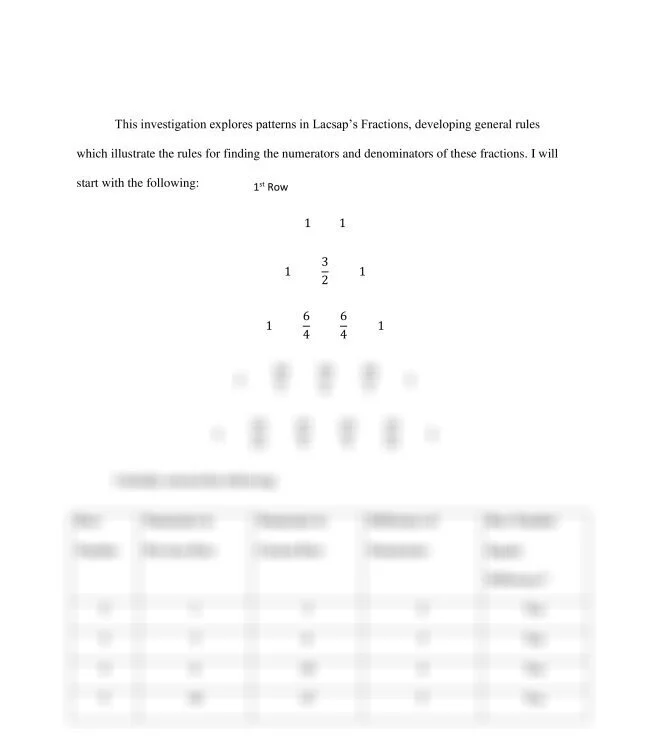This investigation explores patterns in Lacsap’s Fractions, developing general rules which illustrate the rules for finding the numerators and denominators of these fractions. I will start with the fo
This investigation explores patterns in Lacsap’s Fractions, developing general rules which illustrate the rules for finding the numerators and denominators of these fractions. I will start with the fo
( (0)=((1/2) (0)=1 (1)=((1/2) (1)=((1/2)4+1)/((1/2)4+1-2+1) (1)=((1/2)64+4)/((1/2)64+4-8+1) (1)=(2+1)/2 (1)=(32+4)/(32-3) (1)=3/2 (1)=36/29 (1/2) (2)=10/6 (4)=15/11 (n) (n)=((1/2) (n)=1 (r) (r), (r)=((1/2) (refer ) 0 0, 0≤r≤n 0≤r≤n. 1 1. 10 10) 10/6 10/7 10th 11 15 15/11 15/9 2 21/12 21/13 21/16 28/16 28/18 28/22 2^2+(1/2)2)/((1/2) 2^2+(1/2)2-(2)(1)+(1)^2 3 3/2 36/20 36/21 36/24 36/29 4 4+2=6 45/25 45/27 45/31 45/37 5 55/30 55/31 55/34 55/39 55/46 5=r^2-5r+15 5th, 6 6+3=9; 6/4 6=r^2-6r+21 6th 6th, 7 7=r^2-7r+28 7th 8 8, 8^2+(1/2)8)/((1/2) 8^2+(1/2)8-8(1)+1^2 8th, 9 9+4=13. 9, 9th, =0 After Before Current Decominators Denominators Difference Difference? E_2 E_4 E_5 E_8 E_n Equals Example: E〗_n First Fractions Fractions, Fractions: From GDC GDC, I It Lacsap’s Looking Neither Next, Number Numerator Numerator=(1/2) Numerators Order Previous Putting Refer Regression Row Rows Second Seeking Term The There This To Using Valid? Values Where With Working Yes a above accepting added additional aforementioned again algebraically all also always an analysis and any appearing appears as at attempts ax^2+bx+c: b be because because, beginning below: between both building but by by: c calculate calculated calculating can cannot change combine common completed confirmed continue correct. current decided defined denominator denominator: denominators determine determined determining developing diagonal dictates: difference difference, direction direction, direction. discussed, downward each earlier end enough equal equaled equation equation: equations example except exists explained explores failed find finding first fit five follow following following: for form form, formula formulated formulated. found four fraction, fraction. fractions. from further general given going graph had here, higher how however, illustrate illustrated illustrates imaginary. in increase indeterminate(0/0). individually information initially inside integers investigation irrational, is it it, its kind last limitations look many me moving must my n n, n=Row n=row n^2+(1/2)n n^2+(1/2)n) n^2+(1/2)n)/((1/2) n^2+(1/2)n, n^2+(1/2)n-n(0)+(0)^2 n^2+(1/2)n-n(n)+(n)^2 n^2+(1/2)n-nr+r^2 n^2+(1/3)n negative, next nor noticed now nr-r^2 number number, number,r=term number: numbers numerator numerator, numerator: numerators numerators, n≥1 o observed of on one only opposite or order outside outsides page pattern pattern. pattern: patterns patterns. pieces positive predecessor. previous provides quadratic quadratic. r r=n) r^2-nr+(1/2) rational, recognized regression relation relation. represented rest result results row row, row,n≥1,and row. rows rows. rows: rule rule: rules same satisfied saw saw, scope second section seventh should shows similar six sixth start statement statement, statement: step strategy successive such symmetrical. symmetry table table. term terms test tested tests, than that that, the then there therefore therefore, these they this this, three to together, triangle triangle, triangle. triangle: triangle=(1/3) tw two two. uncover: used using valid value values values: variable variables was well: what where which will with within would x-axis y-axis, –n “E” “n” “r” 〖
This investigation explores patterns in Lacsap’s Fractions, developing general rules which illustrate the rules for finding the numerators and denominators of these fractions. I will start with the following:
1 1
1 3/2 1
1 6/4 6/4 1
1 10/7 10/6 10/7 1
1 15/11 15/9 15/9 15/11 1
I initially noticed the following:
Row Number Numerator in Previous Row Numerator in Current Row Difference of Numerators Row Number Equals Difference?
2 1 3 2 Yes
3 3 6 3 Yes
4 6 10 4 Yes
5 10 15 5 Yes
To find the numerator in the 6th row, 6 must be added to 15 because with each successive row, the row number is added to the previous numerator to find the current numerator, as illustrated by the above table. Next, I decided to graph the relation between the row number and the numerator:
